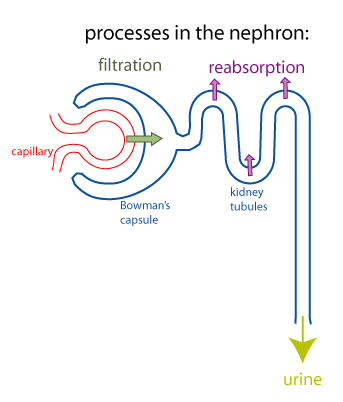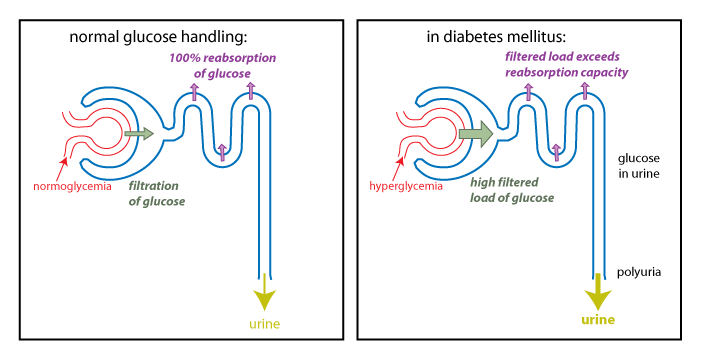Polyuria in Diabetes Mellitus
Diabetes comes from the Greek word which means “siphon”. There
are two distinct disorders that share the first name diabetes:
diabetes mellitus and diabetes insipidus. This is because both
disorders can cause polyuria,
or excessive urine output. Diabetes insipidus is a disorder or
urine concentration that we will consider in the next quiz
section.
Diabetes mellitus is a
disorder of blood glucose regulation, which results from a
deficiency in the action of the hormone insulin. This may
be due to autoimmune destruction of the insulin-secreting cells of
the pancreas (type 1 diabetes mellitus) or it may result
from a problem in the responsiveness of tissues to insulin, known
as insulin resistance (type 2 diabetes mellitus).
With either disorder, the result is hyperglycemia,
or high levels of glucose in the plasma. In many cases
hyperglycemia does not cause any symptoms, but in some individuals
it causes excessive urination and increased thirst.
 How does hyperglycemia cause
excessive urine production? To answer this, we need to understand
a little bit about how the kidney works. Each kidney contains
about a million functional units called nephrons
(blue structure in the figure). The first step in the production
of urine is a process called filtration
(green arrow). In filtration, there is bulk flow of water and
small molecules from the plasma into Bowman’s capsule (the first
part of the nephron). Because of the nonspecific nature of
filtration, useful small molecules such as glucose, amino acids,
and certain ions end up in the forming urine, which flows into the
kidney tubules. To prevent the loss of these useful substances
from the body, the cells of the kidney tubules use epithelial
transport to transfer these substances out of the forming urine
and back into the extracellular fluid. This process is known as reabsorption (purple arrows).
Reabsorption of glucose specifically occurs in the proximal tubule.
How does hyperglycemia cause
excessive urine production? To answer this, we need to understand
a little bit about how the kidney works. Each kidney contains
about a million functional units called nephrons
(blue structure in the figure). The first step in the production
of urine is a process called filtration
(green arrow). In filtration, there is bulk flow of water and
small molecules from the plasma into Bowman’s capsule (the first
part of the nephron). Because of the nonspecific nature of
filtration, useful small molecules such as glucose, amino acids,
and certain ions end up in the forming urine, which flows into the
kidney tubules. To prevent the loss of these useful substances
from the body, the cells of the kidney tubules use epithelial
transport to transfer these substances out of the forming urine
and back into the extracellular fluid. This process is known as reabsorption (purple arrows).
Reabsorption of glucose specifically occurs in the proximal tubule.
Under normal circumstances, 100% of the glucose that is filtered
is reabsorbed. Glucose reabsorption in the kidney proximal tubule
utilizes the same basic process as glucose absorption in the small
intestine (as outlined in the page on Epithelial
Transport). In a diabetic that has hyperglycemia, the filtered
load of glucose (amount of glucose filtered) can exceed the
capacity of the kidney tubules to reabsorb glucose, because the
transport proteins become saturated.
The result is glucose in the urine. Glucose is a solute that
draws water into the urine by osmosis.
Thus, hyperglycemia can cause a diabetic to produce a high volume
of glucose-containing urine.

SGLT2 Inhibitors
In the past few years, drugs have been developed that exploit
glucose loss in the urine as a means to counteract hyperglycemia
in diabetes mellitus. These new drugs are SGLT2 inhibitors, inhibiting the
sodium-glucose cotransporter (SGLT2) that is specific to the
kidney tubules. About 90% of renal glucose reabsorption
occurs via SGLT2. There are now five FDA-approved SGLT2
inhibitors on the market*. In trials, these drugs have been
shown to reduce hyperglycemia, promote weight loss, and cause a
small reduction in blood pressure.
SGLT2 inhibitors are important new drugs for the treatment of
diabetes mellitus for several reasons. Since they work via a
mechanism that is independent of insulin secretion or action, it
may be safer to add them to existing treatments. Perhaps most
encouraging, however, is that several large studies have shown
than SGLT2 inhibitors are able to decrease the risk for
cardiovascular disease and to slow the progression of diabetic
kidney disease. Preventing or delaying cardiovascular and
kidney disease is an important goal since these diseases are major
causes of mortality in diabetics.
*SGLT2 inhibitors all have "-gliflozin" as a suffix in
their generic name. Canagliflozin (tradename:
Invokana) was approved in May 2013. Dapagliflozin
(tradename: Farxiga) was approved in January 2014.
Empagliflozin (tradename: Jardiance) was approved in
August 2014. Ertugliflozin (tradename: Steglatro)
was approved in December 2017. Bexagliflozin
(tradename: Brenzavvy) was approved in January of 2023.
 How does hyperglycemia cause
excessive urine production? To answer this, we need to understand
a little bit about how the kidney works. Each kidney contains
about a million functional units called nephrons
(blue structure in the figure). The first step in the production
of urine is a process called filtration
(green arrow). In filtration, there is bulk flow of water and
small molecules from the plasma into Bowman’s capsule (the first
part of the nephron). Because of the nonspecific nature of
filtration, useful small molecules such as glucose, amino acids,
and certain ions end up in the forming urine, which flows into the
kidney tubules. To prevent the loss of these useful substances
from the body, the cells of the kidney tubules use epithelial
transport to transfer these substances out of the forming urine
and back into the extracellular fluid. This process is known as reabsorption (purple arrows).
Reabsorption of glucose specifically occurs in the proximal tubule.
How does hyperglycemia cause
excessive urine production? To answer this, we need to understand
a little bit about how the kidney works. Each kidney contains
about a million functional units called nephrons
(blue structure in the figure). The first step in the production
of urine is a process called filtration
(green arrow). In filtration, there is bulk flow of water and
small molecules from the plasma into Bowman’s capsule (the first
part of the nephron). Because of the nonspecific nature of
filtration, useful small molecules such as glucose, amino acids,
and certain ions end up in the forming urine, which flows into the
kidney tubules. To prevent the loss of these useful substances
from the body, the cells of the kidney tubules use epithelial
transport to transfer these substances out of the forming urine
and back into the extracellular fluid. This process is known as reabsorption (purple arrows).
Reabsorption of glucose specifically occurs in the proximal tubule.